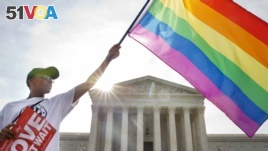24 September 2020
Same-sex marriages now make up a half a million American households, five years after the Supreme Court legalized such relationships.
The U.S. Census Bureau reported last week that the number of married same-sex households has increased by almost 70 percent since 2014. The numbers are based on the Census Bureau's American Community Survey.
The survey found that about 980,000 households in the country belong to same-sex couples. It showed 58 percent, or a little more than 586,000, as married. The other 42 percent lived together outside of marriage.

Carlos McKnight of Washington, waves a flag in support of gay marriage outside of the Supreme Court in Washington, D.C., June 26, 2015. (AP)
There were more female couple households than male couple households, but not by a lot. Gary Gates, is a demographer specializing in LGBT issues. He said, "Opponents of marriage equality frequently argued that same-sex couples really weren't all that interested in marriage. But the large increase in marriages among same-sex couples since marriage equality became legal nationwide offers evidence of the clear desire for marriage among same-sex couples."
The survey showed noticeable economic differences between male couples and female couples, as well as same-sex couples and opposite-sex couples.
The study found that same-sex married couples generally earned more money, with average earnings of about $107,000 a year. That compares to almost $97,000 for opposite-sex couples. Among same-sex marriages, male couples earned more than female couples -- $123,646 compared to $87,690.
The research also found that same-sex married households were more likely to be in the workforce than opposite-sex married households -- 84.6 percent compared to 80.4 percent.
The study showed married women in same-sex households were much more likely to be working than married women in opposite-sex households. But married men in same-sex households were less likely to be working than married men in opposite-sex ones.
Gates said, "While most research that gay and bisexual men, on average, do not earn more than their comparable heterosexual male counterparts, that research also shows that they tend to earn more than lesbian and bisexual women."
Separate survey results also released Thursday show that almost 15 percent of same-sex couples had at least one child under the age of 18. The same is true of a little more than 48 percent of opposite-sex couples.
Of the nearly 300,000 children living in homes with same-sex couples, 66 percent were children of both partners, compared to 95 percent for opposite-sex couples, reports the Census Bureau's Current Population Survey.
The District of Columbia had the greatest concentration of same-sex households. In the nation's capital, about 2.4 percent of households are same-sex households. The nearby state of Delaware followed, with 1.3 percent. The states of Oregon, Massachusetts and Washington came next, all a little over one percent, the survey found.
In the survey, more than 16 percent of same-sex married households were interracial couples, double the rate for opposite-sex married couples.
The U.S. had 122 million households in 2019. The number of gay and lesbian couples in the country is greater than 980,000 since that number only represented same-sex households.
The 2019 American Community Survey for the first time included updated relationship identifications that better captured the number and qualities of same-sex households in the United States.
I'm Caty Weaver.
The Associated Press reported this story. Caty Weaver adapted it for Learning English. Ashley Thompson was the editor.
_________________________________________________
Words in This Story
survey – n. an activity in which many people are asked a question or a series of questions in order to gather information about what most people do or think about something
demographer – n. someone who studies changes, such as the number of births, deaths, marriages, and illnesses, that occur over a period of time in human populations
LGBT – n. short for lesbian, gay, bisexual, transgender and queer
frequently – adj. happening often
heterosexual – adj. sexually attracted to people of the opposite sex
concentration – n. a large amount of something in one place
tend – v. used to describe what often happens or what someone often does or is likely to do
We want to hear from you. Write to us in the Comments section, and visit 51VOA.COM.